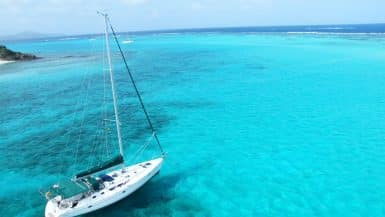Many motorhomes have long been winterized on their parking lot. Winter camping in snow and ice has its own special charm, because even in the freezing cold, outdoor life can be enjoyed to the fullest. If you take the following tips to heart, you will have it wonderfully warm in your camper throughout your holiday.
Winter camping: Insulating the vehicle properly
Powerful heating and good insulation should not be missing on board when winter camping. To ensure that it remains comfortable in the vehicle at all times, a lot of equipment is added. Warm duvets and extra fleece blankets are a must on any trip to the snow. In many vehicles, there are so-called “cold bridges” in the floor area. If the camper has neither carpets nor underfloor heating, sleeping mats or special heating mats are laid out. This means that pets travelling with you will also be comfortable at night. Thermal mats or films on the windows and doors help against cold bridges on the windows. Icy air likes to penetrate the cab. To prevent the cold from entering the living area, a thermal curtain is simply hung between the areas. In the case of a panel van, rear door insulation is also recommended. Especially in winter, many campers shy away from the lengthy construction of the awning. However, as a climate lock and mud flap, it has many advantages. The summer models are not necessarily recommended for icy temperatures. Partial tents are ideal as winter awnings to reduce the snow load, as well as a wide rotten strip that keeps dripping and melt water outside. Another plus is the extra storage space. With a stove, the awning becomes a cozy terrace from which to watch the snow drift.
How is heating used during winter camping?
For winter camping, it is best to use a gas cylinder with a correspondingly high propane content, because the otherwise common butane is not able to change its aggregate state from liquid to gaseous in frost. Suitable models can be found online, for example.
Depending on how well the camper is insulated, the gas consumption is three to five kilograms per day. Two gas cylinders of 11 kg each last about five to seven days in the cold. Nothing is more annoying when winter camping than having to go out into the snow in the middle of the night to change a gas bottle. “Duo-Control” ensures a peaceful sleep. Two gas cylinders can be connected on board. If one is empty, the supply automatically comes from the other bottle. Some vehicles have a gas level indicator in the on-board electronics. If this is not available, the supply can be checked regularly with a gas scale or a special gas checker. Other heat sources on board are:
- Infrared heating
- Catalytic furnaces
- Electric Radiant Heater
- Heating lamp especially for the awning
Important: An electric radiant heater should only be connected in exceptional cases, as the power consumption in the vehicle is already higher in winter due to the early onset of darkness. Whenever possible, shore power should be used and the operation of power guzzlers should be restricted.
This is how the water supply works in winter in a motorhome
A big issue in winter camping is the freezing of the water pipes. Water tanks that can be heated provide a remedy and prevent frost damage to the system. Models with an antifreeze monitor counteract the freezing of the boiler. It should be noted here that the valve opens automatically at an ambient temperature of below four degrees Celsius and the water runs out. Before filling, the on-board heating is therefore put into operation one hour in advance. Most of the waste water tanks in the camper are not heatable. Here it helps to place a bucket under it and simply let the water drain away. If you don’t want the water to freeze, an antifreeze is added directly to the bucket. This is also filled into the sinks shortly before the caravan is parked so that the water in the pipes does not freeze. In frost, smaller tanks can no longer be emptied properly, which is why a bucket as large as possible is placed under it for the only slightly soiled gray water. If the grey water tank is not insulated, the drain gate valve is permanently opened at very low temperatures and a collection container is placed underneath.
Feel good in the right place
The success of winter camping stands and falls not only with the right preparation and equipment, but also with the place. If you are not a fan of a survival holiday, look for a place with heated sanitary facilities and drying rooms for ski equipment and other laundry. If it does get too uncomfortable in the camper, lounges with Wi-Fi are practical. The relaxation factor is also significantly increased if there is a sauna, steam bath or even an indoor pool on the course.




